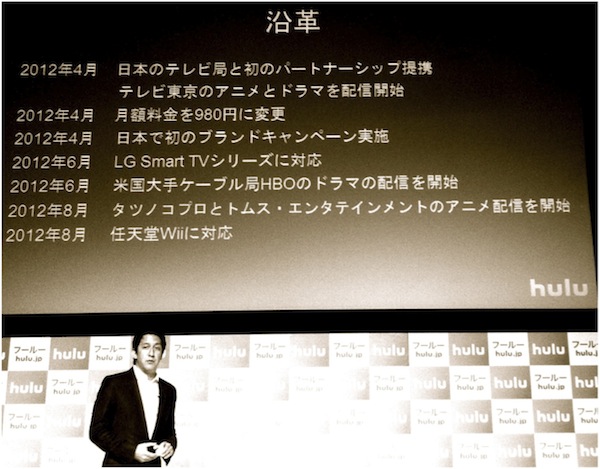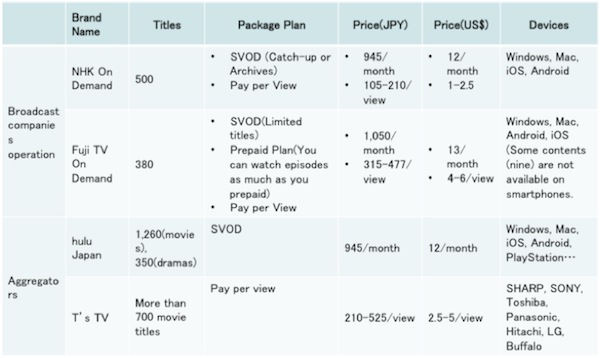
Buddy Marini, Managing Director of hulu Japan
hulu to Keep Adding Local Contents
“We will keep to pick up local popular contents” said at the press conference in the end of August Mr. Buddy Marini, the managing director of hulu Japan, and a Chinese foods lover(^_^)
They cut the deal with Tsuburaya production that own classic titles such as ULTRAMAN series. wow
Hulu Japan has launched in September 2011 as the first abroad wing of the US hulu. Now they become one of the largest video platforms in the local market.
Who should initiate VOD market in Japan?
Japan is the world second largest market for contents business and more than 40% of household has broadband connection. No one might doubt that innovative video services have achieved huge success here. The reality, however, has not been different so far.
The main reason for that is the broadcast industry, as the main video contents player has not show the enthusiasm for VOD services.
Complicated Experiences of VOD
Networks’ VOD provides relatively plenty of titles. TBS on demand provides over 800 titles and NHK on demand does more than 500 titles. TSUTAYA TV, aggregators, provides more than 5,000 titles from foreign films to niche comedy stage shows. Looks good.
The price to watch contents is around 100 JPY to 400 JPY, US$1-5, per view. Subscription fee costs around 1,000 JPY, US$12. Not so expensive. (A Big Mac in Japan costs 320 JPY, US$4(^_^))
Plenty of titles are provided with inexpensive price. But no success of VOD has come yet. Why?
My assumption is that each service requires too much complicated procedures to buy contents. The user experience is terrible. Here are some examples.
Brand schizophrenia: TBS on demand distributes its titles to many aggregators. We have to sign up different aggregators depending on titles and devices that you want to buy and use. Some dramas are available only on Windows PC and others are only on TV. So, contents under TBS brand fragmentized in terms of devices and platforms. Users don’t understand where and how to buy contents.
Complicated package plans: Fuji TV on demand provides monthly SVOD service. But this SVOD plan enables users to watch only 8 titles a month, not brand-new. More over, users don’t have the right to choose titles. Fuji TV chooses titles and packages those. It is not interesting and complicated for users…
Fuji TV have seven of monthly plan including prepaid and this limited SVOD. Would not it be too many that seven monthly package plans for 380 titles that they provides on VOD service?
Plug-in Requirement: TSUTAYA TV requires users to download plug in players. It might be because the contents protection from pirates. But, plug-in requirement has been dead few years ago due to the technology progress. Few players such as Amazon Instant Video still requires plug-in.
With those examples, Japanese VOD services develop the user experience meticulously but results turns out be too much and complicated.
It seems to me that networks hesitate to expand VOD in Japan.
Contents right holder VOD service
According to MIC (Ministry of Internal Affairs and Communications), the VOD market value is exceeded to 70 billion JPY, which is only 4% of whole five major networks revenue in 2011. The five major networks earned 1.6 trillion JPY, US$20 billion. The total digital revenue of them accounts only for 1.4% to the whole revenue in the fiscal year of 2011. It seems that they don’t leverage their assets by using Internet. (i.e., NTV, one of networks, production cost accounted 31% to the whole revenue of NTV.) Why?
Some might say that copyright issues prevent them from moving forward. Copyrights of TV shows are fragmentally owned and networks don’t control all. It is just uneconomic that they solve copyright issues for VOD with many efforts. This could be the reason that VOD services give users very complicated experiences.
Most comprehensive SVOD service in Japan could be NHK on demand. But, even they have two SVOD services, one is for catch-up viewing, the other is for archive viewing. Each SVOD package costs 945 JPY, around US$12, a month. Copyright issues might be the reason they separate VOD service in two, but it was not good experience for consumers definitely.
The revenue of NHK on demand in the fiscal year of 2012 is planed to be 2.4 billion JPY, US$3 billion. As of the end of September 2012, the number of its subscribers is 930,000 including free subscribers.
Some content right holders launched VOD services as well. Warner Bros. Studios launched Warner ON DEMAND. FOX on demand is operated on the cable operator’s platform. But those don’t provide brand-new titles. Foe example, FOX on demand delivers “Walking Dead” of the season 2 while hulu Japan does the same title’s season 3.
Aggregators of VOD
In 2007, the big TV manufacturers made joint venture called “acTVilla”, the first video platform to the living room TV sets. However, five years ago, few TVs are not functioned to connect with Internet and very small archives didn’t attract consumers. It has not generated profit yet. One source said that in the fiscal year of 2010, the revenue was 290 million JPY and recorded 700 million losses.
Other platforms such as Gyao!, TSUTAYA TV or T’s TV provide mainly pay per view bases VOD services. They have plenty of titles but have not achieved big attention in the market so far. (Those three above VOD platforms don’t open the details.)
There are several aggregators for broadcasting contents such as “Motto-TV” and “Dogatch”. Two aggregators complement the fragmentation of broadcasting VOD platforms.
Motto-TV focuses on providing transaction system. You can buy any programs from all five major networks without any sign-up process. Motto TV focuses on distributing video on TV sets. Dogatch tries to expand titles to local broadcast programs. They aggregate programs from 14 television stations including 9 local televisions.

Comparison of VOD platforms in Japan
The Boundary Disappeared in the Global Video Market
As we have been discussing, many VOD platforms have already started business. But why does not the VOD market take off?
One of the reasons is definitely the terrible viewing experience they provide. I feel like playing a difficult puzzle that requires deep thought when I try to watch contents online.
So, only hulu gives us very simple SVOD service with plenty of titles and it is quick. We can watch Saturday Night Live on hulu Japan ten hours after on-aired in the States. (The US hulu distributes NTV’s animation “HUNTER, HUNTER” one hour after the Japanese on-air time.)
iTunes and App Store makes us feel that the border in the contents market has disappeared. hulu gave the same impression in the video market as those music and apps platforms have done for us.
I recall that in 2008, a broadcast industry executive said, “Viewers love shows, they don’t care channels”. Even this digital era, we need a comprehensive platform like hulu where you can have many choices from all channels.


